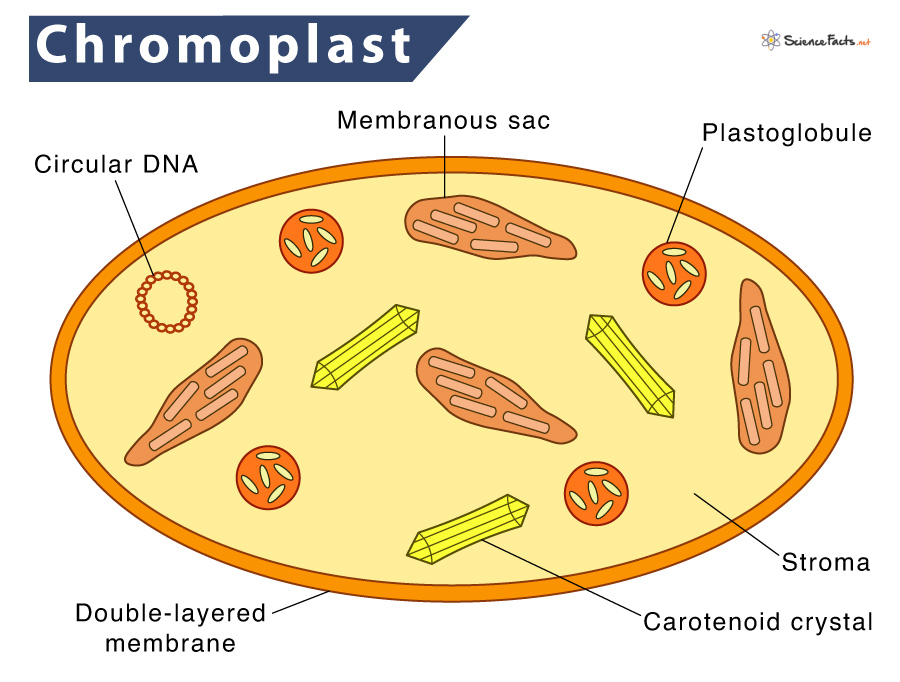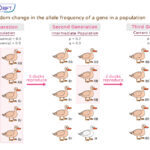Chromoplast
Chromoplast is one of the three main plastids found in plant cells, along with chloroplast and leucoplast. Within a plant cell, they are found in the cytoplasm. Chromoplasts are colored plastids imparting different colors to fruits, flowers, roots, and dying leaves due to the presence of the pigment carotenoid.
In Greek, ‘chroma’ means ‘color’, which gives this plastid its name.
Characteristics of Chromoplast
- They have a double-layered membrane with circular DNA.
- They mainly originate through the differentiation of chloroplast. However, chromoplast also develops from leucoplasts, like watermelon, papaya, carrot, and mango.
- Unlike chloroplast, chromoplast is non-photosynthetic and thus is not involved in plant food production.
- Carotenoids are classified into carotenes and xanthophylls. Carotenes impart orange color to colorful vegetables like carrots. In contrast, xanthophylls impart yellow color, found in young, etiolated leaves and fruits like papaya, squash, and peaches.
- Carotenes are composed of carbon and hydrogen. An example of carotene is lycopene. In xanthophylls, oxygen is present. Fucoxanthin and lutein are two examples of xanthophylls.
How are Chromoplast Formed
As we know, they originate through chloroplast differentiation, having the green pigment chlorophyll. During differentiation, there are some visible changes in a chloroplast like:
- Degradation of chlorophyll and the thylakoid membrane
- Significant increase in carotenoid-accumulating bodies such as plastoglobules, microfibrillar structures, crystalline structures, and membranous structures within the newly formed pigment body
- DNA remains unchanged, but ribosomes and rRNA disappear.
- The green pigment, chlorophyll, is transformed into the colored chromoplast.
The presence of nutrients, light, and adequate temperature is essential for chromoplast differentiation.
Structure of Chromoplasts with Types
Unlike chloroplasts, chromoplasts vary in size but are comparatively smaller. The interior of these plastids contains large molecular structures called fibrils that contain lipid droplets. However, the outer membrane consists of fibrillin proteins of size 35kD.
Based on the structural differences and the carotenoid-bearing components, chromoplasts are classified into five types as seen under an electron microscope.
1. Globular
They are simple chromoplasts characterized by the presence of lipoprotein particles called plastoglobules bearing carotenoid pigments.
They are found in perianth of citrus fruits, capsicum of yellow fruit, and in petals of Ranunculus repens.
2. Membranous
These chromoplasts have carotene pigments in about 20 concentric membranes.
They are found in tulips and daffodils and also in the petals of Citrus sinensis.
3. Tubular
In such chromoplast, the carotenoid pigments are typically present in the lipoprotein tubules.
Tubular chromoplasts are found in rose, hypanthium, and colored fruits of capsicum.
4. Fibrillar
Here, the carotenoid pigments are present in bundled microfibrillar-shaped chromoplasts.
They are found in pepper.
5. Crystalline
As the name suggests, such chromoplasts contain crystals of lycopene and beta-carotene.
They are found in carrot roots and tomatoes.
Redifferentiation of Chromoplasts
Sometimes chromoplasts may transform back to chloroplasts, a process called regreening. It can occur due to various factors and in different parts of the plant.
This process is characterized by increased chlorophyll content as well reduction in carotenoids. For instance, chromoplasts in carrot roots, citrus fruit, pumpkin, and cucumber lose carotene and develop chlorophyll and thylakoid system again. This redifferentiation is promoted by two plant hormones, gibberellin and nitrates.
Functions of Chromoplasts
- As they impart vibrant colors to various plant parts, they help attract animals and insects for cross-pollination and seed dispersal.
- Carotenoids act as antioxidants.
- Beta-carotene found in carrots is a precursor of vitamin A.
- Dietary carotenoids reduce the risk of cardiovascular diseases and cancer.
- Fucoxanthin is proven to have anti-diabetic and anti-obesity effects.
Chromoplast vs Chloroplast
Though both chromoplast and chloroplast are pigmented plastids, they have many differences.
Differences
| Basis | Chromoplast | Chloroplast |
|---|---|---|
| 1. Look | Yellow, orange, or red in color | Green in color |
| 2. Name of Pigment | Contains carotenoids | Contains chlorophyll |
| 3. Location | Found in non-green parts of a plant, such as petals of a flower, ripening fruits, and aging leaves | Found in the green parts of a plant, such as leaves and young stem |
| 4.Main Function | Helps in cross-pollination and seed dispersal | Helps in photosynthesis |
| 5. Lamellar System | Absent | Present |
| 6. Ribosomes | Absent | Present |
However, they share some common characteristics as well.
Similarities
- Contain pigments
- Remains surrounded by two membranes
- Contain identical DNA
- Divide by binary fission
- Found in the exposed parts of the plant
Differences between Chloroplast, Chromoplast, and Leucoplast
| Basis | Chloroplast | Chromoplast | Leucoplast |
|---|---|---|---|
| Color | Green | Yellow, orange, red | Colorless |
| Pigment | Contain chlorophyll and other carotenoids | Contain carotenoids and xanthophylls | Do not contain any pigment |
| Function | Producing food as carbohydrate | Providing colors to plant leaves, flowers, and fruits. Help in attracting pollinators | Storing proteins, starch, and fats |
| Lamellar System | Absent | Present | Have several nucleoids and uniform granular stroma |
-
References
Article was last reviewed on Friday, February 17, 2023






